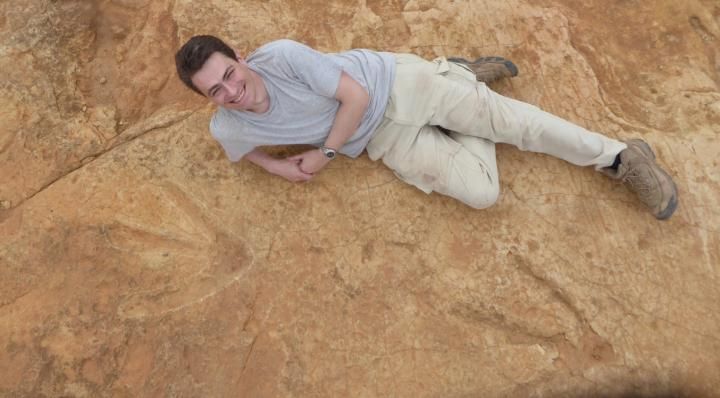
Two hundred million years ago, in the early Jurassic, a giant carnivore roamed what is now southern Africa. It left tracks in the mud, which hardened and became the first proof that giant, T. rex–like predators lived in that era.
The newly discovered dinosaur, called Kayentapus ambrokholohali, was estimated to be 9 meters long, or 30 feet, or a little longer than a London bus. T. rex, by comparison, was 12 meters long. The formal description of the animal was released today in the journal PLOS One.
Theropods are a group of dinosaurs that usually walk on two legs and have sharp teeth. They are characterized by their hollow bones and three-toed limbs, and include such dinosaur favorites as Tyrannosaurus, Spinosaurus and Velociraptor, and technically even modern birds. Until this discovery, it had been assumed that the group of large theropods, called megatheropods, hadn't evolved yet in this era; theropods were only known to grow about 3 to 5 meters, or occasionally up to 7 meters long during the early Jurassic. This pushes back the known evolution of megatheropods by 55 million years.
K. ambrokholohali left no known bones, but just a trace of its existence. As the carnivore walked across sediment on the ancient continent of Gondwana, it created "trace fossils," or remains that show an animal's activity. There were also smaller theropods that left tracks in the area as well, and even tail and body impressions. Trace fossils of footprints are relatively rare. While many are often found in the same area, it takes a very specific set of geological circumstances for footprints to be preserved, and then last hundreds of millions of years to be documented by humans.

Although K. ambrokholohali is known only from footprints, paleontologists can speculate with a fair amount of certainty a lot more than the size and shape of their feet. Importantly, they can compare this animal to other theropods, and make scientific guesses that they probably looked and acted similar to related dinosaurs for which we have more complete fossils.
However, there's a lot they still don't know. Behaviors don't fossilize well, gait notwithstanding. We also know precious little about the sounds, smells or external look of dinosaurs. Soft tissue doesn't fossilize very often, so there could be lots of things about theropod dinosaurs that we don't know—such as how much fat they had, their colors, or even if they had combs and wattles like chickens. We know that many theropod dinosaurs had feathers, some with complete wings, but we don't know if this new one had them, or to what extent.
While it's extremely lucky that this animal's fossilized tracks were found, it makes you wonder: What other bizarre, ancient animals walked the earth but never left a trace?
Uncommon Knowledge
Newsweek is committed to challenging conventional wisdom and finding connections in the search for common ground.
Newsweek is committed to challenging conventional wisdom and finding connections in the search for common ground.
About the writer
Kristin is a science journalist in New York who has lived in DC, Boston, LA, and the SF Bay Area. ... Read more
To read how Newsweek uses AI as a newsroom tool, Click here.








